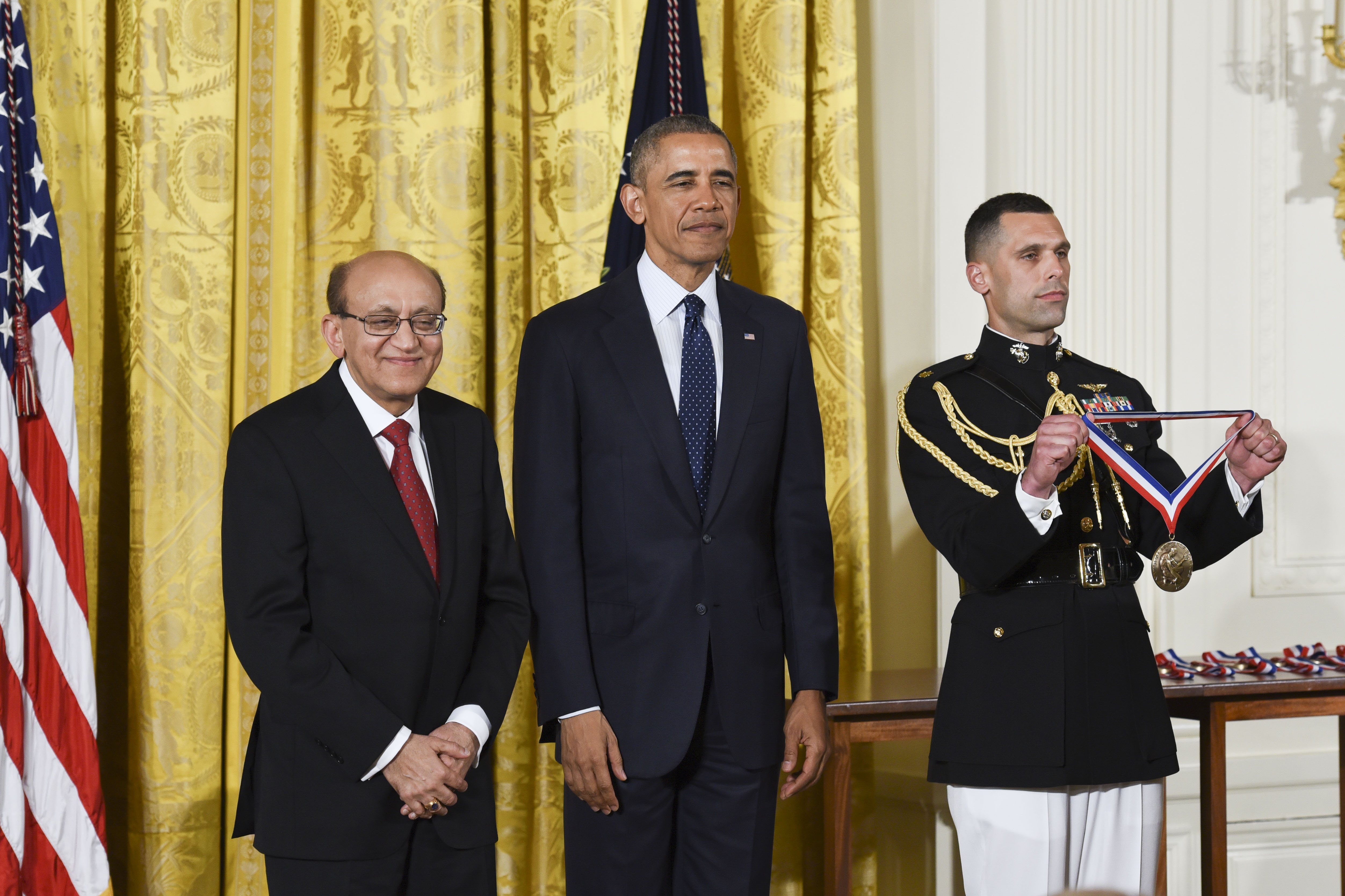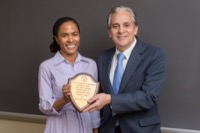Of superheroes and world changers
Two UD professors inducted into National Academy of Inventors
2:54 p.m., April 21, 2016--You might say that curiosity got the best of University of Delaware inventors Norman J. Wagner III and the late Richard F. Heck. And we’ve undoubtedly been the beneficiaries of their scientific sleuthing and tinkering.
The two were inducted as fellows into the National Academy of Inventors on Friday, April 15, in ceremonies at the United States Patent and Trademark Office in Alexandria, Virginia.
Honors Stories
National Medal of Science
Warren Award
Heck, the Willis F. Harrington Professor Emeritus of Chemistry until his death in October 2015, was a 2010 recipient of the Nobel Prize in Chemistry, for “palladium-catalyzed cross couplings in organic synthesis.” The chemical reaction he created, known as the “Heck Reaction,” changed the world in many fields, including pharmaceutical manufacture and discovery, DNA sequencing and electronics. This video highlights the life and accomplishments of the humble Heck.
Wagner, who is the Unidel Robert Pigford Chaired Professor of Chemical and Biomolecular Engineering, answered some questions for UDaily about developing super-hero materials called shear thickening fluids – some that he has developed into “liquid armor” – and what it’s like to be an inventor.
Q. You’re noted for developing shear thickening fluids. What exactly are they?
Wagner: Shear thickening fluids (or STFs for short) are dispersions of nanoparticles in a fluid that respond to an applied force or stress such that the harder you try to make them flow, the stiffer they become. You can experience the STF-like effect in common science demos that use “oobleck” — cornstarch and water. It acts like a solid when you run across the surface, but if you stop, it becomes like a fluid and you sink in. Check out the MythBusters YouTube video on this topic — lots of fun.
Q. What was the process of discovery like, and how long did it take?
Wagner: We started studying the fundamental science of these unique materials over 20 years ago through a research project funded by the National Science Foundation. Over time, once we understood the mechanism responsible for the shear thickening effect, we learned how to formulate and engineer STFs for specific applications, such as body armor.
Q. What kinds of STF applications are you developing? Are there products we’re using now that contain these UD inventions?
Wagner: Here in the Department of Chemical and Bimolecular Engineering at UD, we are working with NASA with the support of the Delaware Space Grant Consortium to develop “armor” layers for use in space suits. Traveling to Mars and living and working in environments such as the moon or Mars will require flexible, robust protection against punctures, abrasion and micrometeoroids. Our joint research with NASA shows STFs can be used to improve astronaut protection — we have an experiment planned on the International Space Station this year. In another project, we’re trying to mitigate concussions by using STFs in helmet padding, with the goal of providing added protection against high-energy impacts that defeat current technologies. A doctoral student in biomechanics and movement science is designing improved transtibial (below-the-knee) prosthetic devices using STF-based dynamic ligaments, with the goal of providing a more life-like artificial lower leg without the need for batteries and motors.
With Dr. Richard Dombrowski, who received his bachelor’s degree in chemical engineering from UD, we founded STF Technologies LLC to license the STF patents from UD and to translate these inventions into commercial practice. Our company is moving into laboratory space on the STAR Campus this month, and we have existing and pending contracts with leading companies in the medical, sports, homeland security and military arenas. We continue to explore new applications for these unique materials for a broad range of applications in improving personal protective equipment. For example, check out the U.S. Army’s development of dynamic ligaments for use by NFL players and soldiers — we’re assisting the Army scientists by engineering STFs to respond as needed in these devices.
Q. Did you always picture yourself as a scientist-inventor?
Wagner: I grew up in a do-it-yourself home where we built the house my parents currently live in and I used my free time to tinker and (re)build things from cars to computers to woodwork. Engineering science is the obvious path for my curiosity-driven lifestyle. It is said that “chance favors the prepared mind,” and a solid education in STEM, such as our students can achieve at UD, can prepare someone to be a successful inventor rather than the “mad scientist in the basement.”
Q. What’s been the most challenging part of the work?
Wagner: Scientists and engineers have great ideas, but translating them into viable commercial products requires additional skills and LOTS of patience and fortitude. Sometimes the world is not quite ready to know that it needs a new invention. Our society needs to work on its scientific literacy, and I hope that UD will continue to strengthen its general education program to reflect this.
Q. What’s been most rewarding?
Wagner: I have been blessed to work with some of the best people anyone can hope to meet along this journey. I really have to thank the exceptional students, postdocs and colleagues who have been involved and continue to be involved in this adventure. This includes past and previous members of UD’s OEIP — thanks!
Q. What advice do you have for others who aspire to be an inventor?
Wagner: Keep learning — keep tinkering and believing — and don’t forget to actually talk to the people who will (hopefully) want to use your invention! Lucky for those who wish to be inventors, UD continues to develop a culture of entrepreneurship that can help foster and support your efforts to achieve your dreams — go for it!
Article by Tracey Bryant
Animation by Jeffrey C. Chase
Photo by Evan Krape













